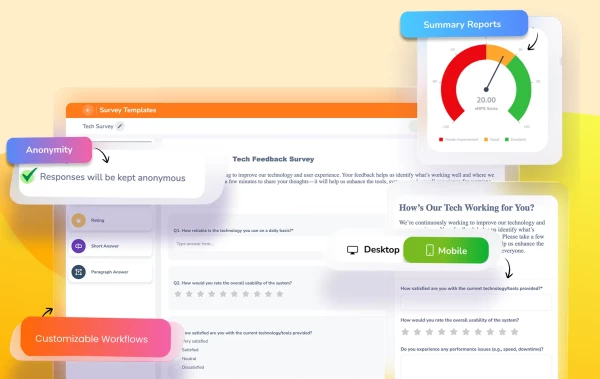As experts in organizational psychology and employee relations, we understand that a successful organization isn't just about having the right talent; it's about asking the right questions to keep that talent engaged, motivated, and aligned. The modern employee survey, exemplified by best practices like those outlined in the Mentimeter guide, transcends mere "satisfaction checks." It is an organizational diagnostic tool, a mechanism to measure psychological safety, identify culture risks, and, crucially, map the future of career development.
The true power lies not just in the answers, but in understanding why specific questions are asked and the strategic actionable insights they yield. Ignoring this foundational understanding turns data into noise and surveys into exercises in futility, directly impacting employee retention and organizational trust.
Section 1: Decoding the Core Drivers of Employee Well-being and Engagement (Questions 1-10)
The first step in any robust employee survey is to establish a baseline for employee engagement and overall psychological safety. These questions probe the fundamental security and belonging that underpin performance.
1.1. Psychological Safety and Trust
These questions aim to measure the foundational elements of a healthy feedback culture. Without safety, all other data gathered will be subject to social desirability bias (where employees answer what they think management wants to hear).
|
Key Question Category |
Example Question (Likert Scale) |
Why is it Important? (Psychological Impact) |
|
Speaking Up/Risk |
I feel comfortable sharing a contrary opinion without fear of negative consequences. |
Directly measures psychological safety. High scores correlate with innovation and early identification of systemic issues. |
|
Trust in Leadership |
I trust senior leadership to communicate honestly and transparently about the company's future. |
Measures organizational trust. Low scores lead to cynicism, disengagement, and rumors, severely impacting change management efforts. |
|
Fairness/Equity |
I believe performance evaluations and promotion decisions are fair and unbiased. |
Addresses distributive and procedural justice. Low scores are a precursor to high voluntary turnover and legal risk. |
The Trade-off: Honesty vs. Actionability
A key psychological and operational trade-off exists here: Anonymity vs. Actionability. To get the most honest feedback on sensitive topics like fairness and trust, surveys should be highly anonymous or confidential. However, high anonymity makes it difficult to pinpoint the exact teams or managers causing the friction, limiting the actionability of the results.
-
Challenge: Leaders must commit to confidentiality (where responses are aggregated with a minimum group size, like 5–10) and communicate this transparently to earn the honesty required to fix systemic trust issues. Failing to clearly define and protect anonymity is a major cause of low participation and dishonest responses—a direct impact on data integrity.
1.2. Role Clarity and Resources
These questions gauge if the employee understands their purpose and is equipped to succeed. Role ambiguity is a classic stressor in employee relations.
-
I clearly understand how my work contributes to the company's overall strategy. (Alignment)
-
I have the resources (tools, budget, time) needed to do my job effectively. (Efficacy)
-
My workload is manageable and allows me to maintain a healthy work-life balance. (Well-being/Burnout Risk)
The Importance of 'Why': The Resources question, often overlooked, is a critical measure of managerial efficacy. If an employee lacks resources, it’s not an employee failure, but an organizational or managerial one. This data segment compels managers to address structural barriers, not just individual effort.
Section 2: Measuring the Engagement and Motivational Factors (Questions 11-18)
Once safety and clarity are established, the next set of questions delves into the motivational drivers: the connection to the team, the feeling of recognition, and the enjoyment of the work itself.
2.1. Team Dynamics and Belonging
Humans are social beings; the quality of peer relationships is a powerful predictor of engagement and resilience.
-
I feel a strong sense of belonging within my team. (Inclusion/Belonging)
-
My teammates and I collaborate effectively to achieve shared goals. (Team Performance)
-
When disagreements arise, my team is able to resolve them constructively. (Conflict Resolution)
The Challenge: Cultural Nuance: Analyzing team dynamic questions requires careful consideration of cultural context. For example, in a high-power-distance culture, a low score on the Conflict Resolution question might indicate an avoidance of conflict rather than an inability to resolve it. Experts in organizational psychology must interpret these scores with cultural sensitivity to ensure the actionable insights lead to effective training, not misdiagnosis.
2.2. Recognition and Feedback
Recognition is the psychological fuel of continued high performance.
-
In the last month, I have received meaningful recognition for my contributions. (Timeliness of Feedback)
-
I receive constructive feedback that helps me improve my performance. (Development Focus)
-
I feel that my compensation (salary and benefits) is fair relative to similar roles. (Equity/Retention)
The Trade-off: Recognition vs. Consistency
The central trade-off here is between personalized recognition (which is highly engaging) and consistent, equitable application of reward systems. The survey data must be cross-referenced with demographic and performance data (confidentially, of course) to ensure recognition is not being disproportionately given to specific groups, which would violate principles of fairness and sabotage employee relations. Low scores on the compensation question, for example, require a serious impact analysis on immediate employee retention risks.
Section 3: The Strategic Future: Growth, Development, and Retention (Questions 19-25)
These final questions are arguably the most forward-looking, directly informing talent management and career development strategy. They bridge the gap between employee sentiment and long-term organizational planning.
3.1. Career Development and Growth
This is where the survey directly informs the Career Development Framework (CDF). These questions measure the perception of opportunities and the clarity of development paths.
-
I have sufficient opportunities for professional growth and learning within this company.
-
I have a clear path for career advancement in my current role.
-
My manager regularly discusses my long-term career goals with me.
-
I believe the company invests adequately in my upskilling and reskilling.
The Importance of Managerial Action: The Manager Discussion question is a proxy for managerial quality in talent development. High scores here mean managers are actively nurturing internal talent, which is the most effective predictor of high internal mobility and lower turnover rates. Low scores indicate a critical need for manager training—not just in leadership, but in structured coaching for career development.
|
Career Development Metric |
High Score Implication |
Low Score Implication (Risk) |
|
Growth Opportunity |
High Internal Mobility potential; strong sense of purpose. |
Brain Drain risk; employees seek growth elsewhere. |
|
Path Clarity |
Effective Succession Planning is possible; reduced uncertainty. |
Low Employee Retention amongst high-potential talent. |
|
Manager Coaching |
Strong Feedback Culture; high managerial engagement. |
Managerial burnout; poor preparation for future leadership roles. |
|
Source: Adapted from common themes in HR and Organizational Psychology research on engagement and talent management. |
3.2. Future Intent and Advocacy
The final questions serve as an immediate retention risk indicator and a measure of brand strength.
-
I see myself working at this company two years from now. (Retention Intent)
-
I would recommend this company as a great place to work. (NPS/Advocacy)
These questions synthesize the responses from all previous sections. A low score on the Retention Intent question, for example, is the culmination of failures across trust, resources, recognition, and lack of perceived career development. It necessitates an immediate, comprehensive impact analysis and action plan.
Section 4: From Data to Development: How OrangeHRM Operationalizes the Feedback Loop

Having gathered and decoded the insights from the 25 best employee survey questions, the organization faces the most critical step: translating feedback into tangible organizational change. This is the ultimate challenge in employee relations—the credibility debt created when a survey is run but no visible action is taken.
This is where a unified HR platform like OrangeHRM becomes indispensable (Reference: OrangeHRM Career Development). OrangeHRM ensures that the deep insights gathered from the psychological diagnostic survey are structurally integrated into daily HR and managerial processes, particularly in the realm of career development.
4.1. Connecting Survey Feedback to the Career Development Framework (CDF)
The key integration points for OrangeHRM in closing the feedback loop are:
-
Surveys Module for Targeted Diagnostics: OrangeHRM's survey tool allows for the easy deployment of the 25 questions, segmenting results by team, tenure, or department. This addresses the Trade-off of Anonymity vs. Actionability by securely aggregating data to pinpoint specific organizational weak spots (e.g., "The Engineering Department scores 2.5/5 on 'Path Clarity'").
-
Performance Management and Goal Alignment: Low scores on the Recognition or Growth Opportunity questions signal a breakdown in the Performance Management system. OrangeHRM facilitates setting SMART goals that are explicitly tied to the Career Development Framework. A manager, having seen their team's low Path Clarity score, can be compelled by the system to schedule mandatory career development discussions and link quarterly goals directly to upskilling milestones within the platform.
-
Individual Development Plans (IDPs): Low scores on the Reskilling Investment question trigger the need for structured IDPs. The OrangeHRM Career Development feature allows managers and employees to collaboratively map out personalized paths, linking the required future skills (e.g., 'Data Science proficiency') to internal training modules or external resources. This transforms a generic survey response into a concrete, measurable plan, ensuring genuine impact on employee growth.
4.2. The Ethical Responsibility: Closing the Loop and Building Trust
The analysis, guided by organizational psychology, confirms that the single greatest factor influencing future survey honesty is whether leaders take visible, timely action on past feedback.
-
Challenge: The action taken must directly address the specific low-scoring themes. If the Workload score is low, the response must be a visible change in process or resource allocation, not a generic team-building exercise.
-
OrangeHRM’s Role: By integrating feedback (Surveys) with follow-up actions (Performance, Training, and Career Development), OrangeHRM provides an auditable, transparent record of organizational responsiveness. This transparency is what rebuilds psychological safety and trust, creating a virtuous cycle where employees believe their voice matters, leading to higher response rates and more honest data in future surveys.
In conclusion, knowing the 25 best employee survey questions is essential, but understanding the organizational psychology behind each one and utilizing integrated HR technology like OrangeHRM to act on the resulting actionable insights is what separates responsive leadership from mere data collection. This strategic approach turns feedback into the engine for career development, high employee retention, and sustainable organizational success.
